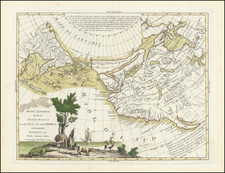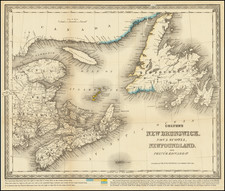"The First Map To Depict Hudson's Bay" (Burden)
First state of Hessel Gerritsz map of the northern regions of Canada and the Arctic, the first map to depict Hudson Bay.
The map was published to accompany the first printed record of Henry Hudson's fourth and final voyage. The career of Hessel Gerritsz, although apprenticed to Willem Jansz. (Blaeu), flourished before that of his master's. Gerritsz became the official cartographer to the Dutch East India Company in 1617, and upon his death in 1632 this title passed to Blaeu.
This remarkable chart showing the regions explored by Hudson, was prepared by Hessel Gerritsz in 1612, to illustrate the track of the fourth and final voyage of Henry Hudson in his hunt for a Northwest Passage.
Henry Hudson had previously made 3 voyages of discovery, the first two in 1607 and 1608 for the English Muscovy Company in search of a Northeast Passage and the third in the service of the Dutch East India Company in 1609, which led to the discovery of the Hudson River. In his final voyage, Hudson, focused his attentions further north, in search of a passage from the Atlantic to the Pacific, in order establish a navigable trading route to China and Southeast Asia.
Hudson set sail on his final voyage in April 1610, ultimately discovering Hudson Bay, before heading south along the eastern shore and before wintering at the southernmost point of James Bay. After a bitter winter, the ice broke and freed the ship in June 1611. A few days later, after his crew mutinied, Hudson was set adrift and was never seen again. There were only eight people from the crew who made it back to England in September of 1611. One of these men, Abacurck Prickett, apparently returned with the manuscript version of this map, which made its way to Amsterdam in 1612, where Gerritsz published the map along with his account of the voyage and issued again the following year by De Bry in his Petit Voyages.
The chart records Henry Hudson's belief that he had found the Pacific Ocean (Mare Magnum), which is named at far left, later named Hudson Bay. What would become James Bay is shown erroneously with two large bays of its own. As noted by Kershaw:
This map serves as the foundation piece to Canada's basic economic history. It served as the only function chart to the northern regions of Canada for several decades, and enabled the successful establishment of the Hudson Bay Company which was to dominate trade, exploration and the economic development of Canada for a long period of time
A landmark map in the exploration of the North Sea and the Arctic. Adorned with a trio of beautiful compass roses, three ships illustrating Hudson's expedition, rhumb lines, a decorative cartouche and the royal crest of Britain.
Rarity
The map is very rare on the market. This is the second example we have offered in over 30 years (1992-2024).
We note a single example offered at auction in the past 50 years (Sothebys, 2011). AMPR notes 2 copies offered in dealer catalogues in the past 40 years.
A smaller copy of the map was issued in 1613 by Theordore De Bry (13 x 6 inches). The easiest way to identify the the difference in the engraving quality is to compar the face in the cartouche directly above the title, which is far cruder in the De Bry edition and virtually unrecognizable as a face. The original Gerritsz edition of 1612 is also more than double the size (22 x 10 inches).
Hessel Gerritsz (1581-1632) was a noted Dutch mapmaker, engraver, and publisher who was also the official hydrographer of the Dutch East India Company. Gerritsz was born in Assum. His first exposure to mapmaking was as an apprentice to Willem Janszoon Blaeu, beginning in 1607. In 1610, Gerritsz began his own publishing business.
Gerritsz’s reputation grew quickly. In 1617, upon the recommendation of Petrus Plancius, Gerritsz was named as the cartographer to the Dutch East India Company (VOC). This meant that Gerritsz had access to the geographical information gathered by VOC navigators, but he could also still sell his own maps to the public. He reviewed the journals of the VOC, then prepared and corrected charts for their ships. In this post, Gerritsz created the first maps to include many new geographic features in the Indian and Pacific Oceans; these included some of the first European encounters with the coast of Australia.










![[ Hudson Bay ] КАРТА ГУДЗОНСКАГО ЗАЛИВА (Carte de la Baye de Hudson)](https://storage.googleapis.com/raremaps/img/small/100628.jpg)
![[ Discovery of the Northwest Passage ] Chart Showing the Recent Search for a North-West Passage. Also the Coast Explored in Search of Sir John Franklin between the Years 1848 and 1854](https://storage.googleapis.com/raremaps/img/small/101874.jpg)


